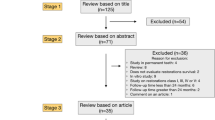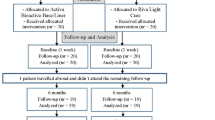Abstract
Data sources A prospective randomised, double-blinded controlled trial
Study selection Those requiring routine dental care in Sihhiye, Turkey were eligible to participate. Eighty-seven participants were identified and assessed for eligibility by calibrated researchers who ensured that the inclusion and exclusion criteria were met. Fifty-nine participants were successfully recruited with an average age of 24 years (range 15-37).
Restoration type were randomly allocated [glass ionomer (GI) or composite resin (CR)] using a table of random numbers with software 'Research Randomised Program' and four experimental groups were created.
Two dentists with 5 years experience were calibrated by them placing ten trial restorations , which were not included in the study. One hundred and forty restorations were then placed adhering to a strict treatment protocol. Cavities which did not meet the specifications of the criteria were excluded.
The study received ethical approval by the Human Ethics in Clinical Research Committee of the University.
Data extraction and synthesis Restorations were assessed at baseline (1 week), 1, 2, 3, 4, 5, 6, 8 and 10 years by blinded calibrated examiners with the aid of colour photographs using an objective criteria. Scanning electron microscopy (SEM) analysis was performed for one randomly selected restoration per group at each assessment.
Data analysis adhered to the intention-to-treat CONSORT protocol. The restoration retention rates were calculated, and statistical analysis preformed using IBM SPSS version 22.0. The performance of the restorative materials over the study period were analysed with Cochran's Q test, according to USPHS criteria. Whilst the McNemar test was used to assess aspects of each material with baseline for each cavity type in addition to difference between cavity types. Marginal adaption, marginal discolouration and colour scores in each study group were compared with the p value set at 0.05.
Results Eighty-seven patients with 203 lesions were included in the study, with 59 (140 lesions) eligible. Eleven patients were excluded for not meeting the inclusion/ exclusion criteria with 17 refusing to participate. Four randomly allocated groups were created at baseline, as combinations of cavity type and restorative material. 86.4% (n=51) of participants were evaluated after 10 years. The cumulative failure rate (CRF) was 3.17%.
Marginal discolouration was observed in all groups at 10 years. With a significant difference observed between Class I and Class II cavities with GI restorations (p = 0.022). In addition, a significant change in colour match in GI restorations after 10 years(<0.005) was found.
Over the ten-year period, no significant change was observed in terms of marginal adaption, anatomical form, secondary caries, postoperative sensitivity, surface texture, and retention for either restorative material (p >0.05) or with SEM inspections.
Conclusions Both GI and CR are suitable and similar restorative materials for class 1 and class 2 cavities. However, differences can occur in colour change within the materials with glass ionomer restorations showing greater colour change from baseline over this period.
Similar content being viewed by others
A Commentary on
Gurgan S, Kutuk Z B, Yalcin Cakir F, Ergin E.
A randomized controlled 10 years follow up of a glass ionomer restorative material in class I and class II cavities. J Dent 2019; DOI: 10.1016/j.jdent.2019.07.013.

GRADE rating
Commentary
Dental materials are continually evolving. Valuing aesthetic, predictable and minimally invasive options. 2017 saw the facilitation of the Minamata convention on mercury, and with it the age of amalgam phase down.1 Highlighting the need for a reliable alternative material. CR is a popular choice commonly used for class 1 and 2 cavities. With properties including high tensile strength and aesthetic benefits. Nevertheless, se nsitivity to water and high shrinkage rate mean it is not always a clear substitute.2
GI is commonly seen as a temporary restoration, with previous studies reporting susceptibility to water uptake, poor tensile strength and retention. Properties have been improved in recent years, creating good handling and the ability to be used with poor moisture control.3
This prospective, randomised, double-blinded controlled trial aimed to evaluate the longitudinal differences of these two restorative materials in class 1 and class 2 cavities over 10 years. Thus, the purpose of this clinical study was to investigate the durability of a glass ionomer in the restoration of Class I and Class II cavities in comparison to composite resins restorations after 10 years. It was hypothesised was that GI restorations would not be as durable as CR restorations.
Conducted in a methodologically appropriate manner this single centred 4-armed design study recruited local people who required dental treatment. All participants were screened for eligibly and randomly assigned to subgroups. However, no mechanisms were used to reduce the confounding of variants. Participant characteristics such as parafunction, the tooth or surface which required restoration or restorative material staining habits such as smoking were not accounted for by stratification, or other methods. Two calibrated clinicians placed the restorations it is unclear if this was accounted for by how the participants were divided.
Bias was minimised using participant blinding. Blinding of clinicians was not possible due to the nature of the study. The dropout rate was 14%, introducing an aspect of attrition bias, as the majority of patients were lost from the Class 2 cavity group.
A power calculation was performed which was not met, therefore the study was under powered. This could cause type II error, ie falsely rejecting the initial hypothesis. Though the inclusion and exclusion criteria were not revealed within the paper, it can be assumed it was strict due to the 32% (n = 27) of enrolled participants not being eligible. This could be in part due to only accepting those with class 1/2 cavities in two posterior teeth, those with less than four cavities and excellent oral hygiene. This in addition to the small geographical area from which participants were drawn, perhaps reduces the potential generalisability of the results as the participants did not necessarily reflect the typical patient attending for dental treatment with generalised dental disease.
The authors investigated the differences in durability and clinical performance between GI and CR restorations. The results indicated no significant difference between failure rates or marginal adaption of the two restorative materials or of the cavity type (p >0.05). However, two patients presented at 4 years with failed restorations but were not present for the 10-year review so were not included in this success rate. Significance was found in the marginal discolouration between both class 1 and 2 GI cavities (p = 0.022), colour match in GI restorations compared to baselines and colour change bravo scores of class 2 cavities between glass ionomer and composite resin restorations.
Overall the above concerns would suggest that the strength of evidence from this study is likely to be very low. However, differing from previous studies this paper provides prospective and longitudinal data on a topical subject and offers conflicting ideas to conventional knowledge. Nevertheless, the results could be misleading due to an inadequate sample size and poor control of confounding factors and bias. Therefore, future high quality randomised clinical trials are recommended to generate stronger evidence.
References
Government Digital Service. Minamata COP1 High Level Segment (2017). Available online at https://www.gov.uk/government/news/minamata-cop1-high-level-segment-uk-statementaccessed 22 August 2019).
Zhou X, Huang X, Li M, Peng X, Wang S., Zhou X, Cheng L. Development and status of resin composite as dental restorative materials. J. Appl. Polym. Sci. 2019; 136: 48180. DOI: .
Sidhu S. Glass-ionomer cement restorative materials: a sticky subject? Aus Dent J 2011; 56: 23-30. DOI:10.1111/j.1834-7819.2010.01293.x
Author information
Authors and Affiliations
Corresponding author
Rights and permissions
About this article
Cite this article
Hutchison, C., Cave, V. 10 year comparison of glass ionomer and composite resin restoration materials in class 1 and 2 cavities. Evid Based Dent 20, 113–114 (2019). https://doi.org/10.1038/s41432-019-0059-9
Published:
Issue Date:
DOI: https://doi.org/10.1038/s41432-019-0059-9



